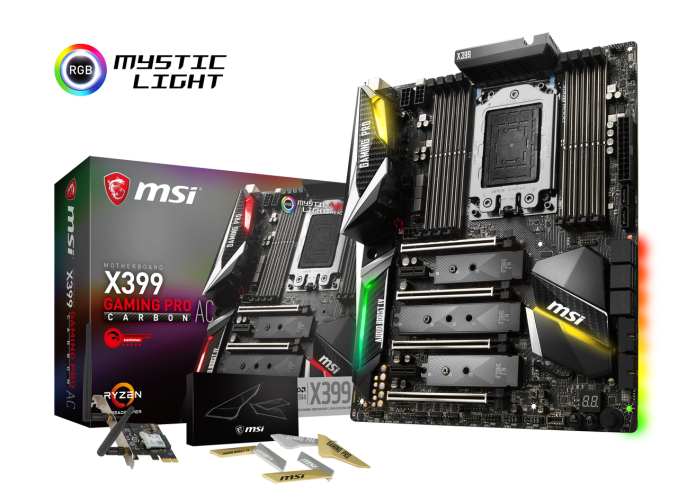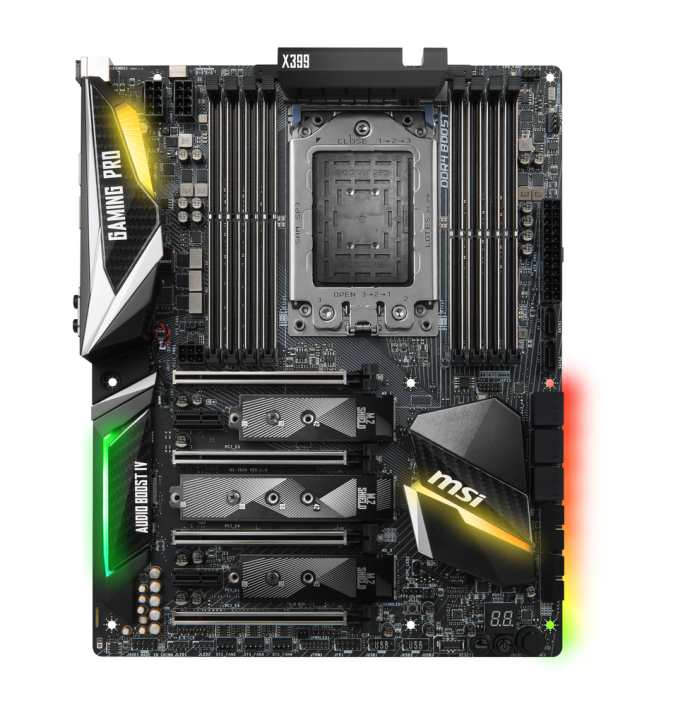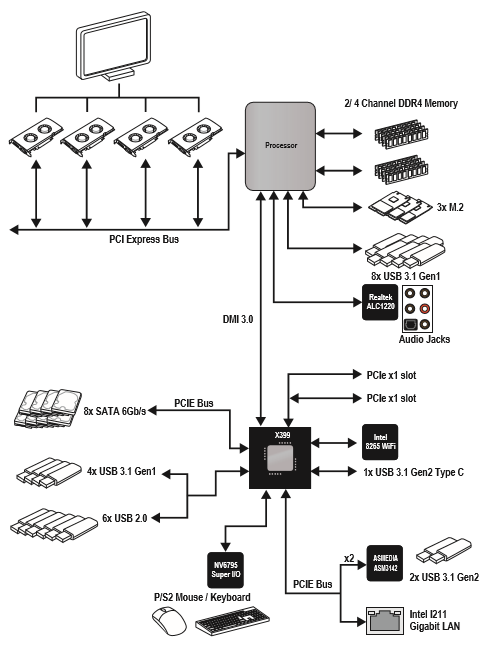An AMD Threadripper X399 Motherboard Overview: A Quick Look at Seven Products
by Ian Cutress & Joe Shields on September 15, 2017 9:00 AM ESTMSI
MSI's initial offering in the X399 space comes in the form of Gaming Pro Carbon AC. This board sits as the high-end board within the Performance Gaming lineup in previous generations. The Gaming Pro Carbon series tends to features for gamers and enthusiasts, using modern audio codecs, wireless capabilities, and aiming for high overclocking abilities.
The MSI X399 Gaming Pro Carbon AC
Starting with the DRAM, we see eight slots covered with MSI's Steel Armor. Memory capacity is the same as other boards, holding up to 128GB in a quad channel configuration, and MSI promotes a maximum supported speed of DDR4-3600, although higher might be possible through overclocking further. MSI is promoting its DDR4 Boost technology, which they say optimizes the traces and fully isolates the memory circuitry for increased stability and performance.
Power delivery for the X399 Gaming Pro Carbon AC is handled by International Rectifier based DrMOS ICs. These are likely either IR3556 or IR 3555 PowIRstages, so either 50A or 60A each. The controller is said to be the IR35201. Power is fed to the VRM by 2x 8-pin 12V CPU (one is optional) located in the upper left-hand corner between the memory slots and rear I/O area. The board has an 8 layer PCB design which MSI mentions is designed to increase efficiency and stability over a standard PCB (it is worth noting that no-one uses a 'standard PCB' for X399). Preaching top quality and stability again, MSI's states its Titanium-II chokes, Dark Caps, and Dark Chokes are 'Military Class 6' certified. The VRM heatsink is unusually tall, to negate the fact it is not connected to anything, but is made out aluminum.
Moving down the board a bit, we can identify four full-length PCIe slots also protected by MSI's Steel Armor surrounding the slots. The Gaming Pro Carbon AC supports 4-Way SLI/Crossfire. In addition to the four full-length connections are two PCIe 2.0 x1 slots fed from the chipset.
For storage purposes, the motherboard has a total of eight SATA ports, six of which are horizontally mounted, while the other two are vertical. There are three M.2 slots also, all of them supporting both PCIe 3.0 x4 drives and SATA drives. Two of the three slots can hold up to a 80mm drives, while the middle M.2 can hold a 110mm drive. All the M.2 ports are nestled between PCIe slots, and use an 'M.2 Shield' to aid with heat dissipation. Unlike some of the other boards, U.2 does not make an appearance on the Gaming Pro Carbon.
Audio output is handled by the Realtek ALC1220 codec working with MSI's Audio Boost 4 suite. MSI updated the Nahimic sound technology to Nahimic 2+, and is now able to apply its audio effects through S/PDIF and Optical connections for non-encoded formats. There is also a dedicated headphone amplifier which auto-detects impedance such that headphones up to 600Ω can be used. The Gaming Pro Carbon also features board isolation of the channels in separate layers of the PCB, filter caps, EMI protection on the audio processor itself (includes built-in DAC), as well as isolation of the audio circuitry from the rest of the motherboard.
RGB LEDs make an appearance on this board as well. Somewhere between the understated ASRock boards and well below the Gigabyte light show is where the Gaming Pro Carbon lands on the spectrum. We can see the LEDs on the rear I/O cover and above the audio on the left-hand side of the board, as well as the chipset heatsink. The last set of LEDs is located under the board below the SATA ports. The Pro Carbon also has two more headers for RGB strips. One for general RGB and the other a rainbow strip. MSI's Mystic Light software controls all the RGB LED functions including those connected to the headers.
MSI included a block diagram of how they break all the lanes down from the CPU and chipset to attached devices.
Below is a complete list of specifications.
| MSI X399 Gaming Pro Carbon | |
| Warranty Period | 3 Years |
| Product Page | Link |
| Price | $379.99 |
| Size | ATX |
| CPU Interface | TR4 |
| Chipset | AMD X399 |
| Memory Slots (DDR4) | Eight DDR4 Supporting 128GB Quad Channel Up to 3600 MHz (OC) Supports ECC UDIMM (in non-ECC mode) |
| Network Connectivity | 1 x Intel I211 Gigabit LAN controller |
| Onboard Audio | Realtek ALC1220 |
| PCIe Slots for Graphics (from CPU) | 4 x PCIe 3.0 x16 |
| PCIe Slots for Other (from Chipset) | 2 x PCIe 2.0 x1 |
| Onboard SATA | 8 x Supporting RAID 0/1/10 |
| Onboard SATA Express | None |
| Onboard M.2 | 3 x PCIe 3.0 x4 - NVMe or SATA |
| Onboard U.2 | None |
| USB 3.1 | 1 x Type-C (ASMedia) 1 x Type-A (ASMedia) 1 x Header (Chipset) |
| USB 3.0 | 8 x Rear Panel 2 x Header |
| USB 2.0 | 2 x Rear Panel 2 x Header |
| Power Connectors | 1 x 24-pin ATX 2 x 8-pin CPU 1 x 6-pin PCIe |
| Fan Headers | 1 x CPU (4-pin) 1 x Water Pump (4-pin) 4 x System Fan (4-pin) |
| IO Panel | 1 x Clear CMOS button 1 x BIOS FLASHBACK+ button 1 x PS/2 keyboard/mouse combo port 2 x USB 2.0 Type-A ports 8 x USB 3.0 Type-A ports 1 x LAN (RJ-45) 1 x USB 3.1 Type-A port 1 x USB 3.1 Type-C port 5 x Audio Jacks 1 x Optical S/PDIF OUT connector |

















99 Comments
View All Comments
Vorl - Friday, September 15, 2017 - link
Heads up, the X399 Taichi product link is linked to the pro gaming motherboard link.milkod2001 - Friday, September 15, 2017 - link
Grossly overpriced boards. Cay they drop this LED nonsense & ugly plastics and make proper boards at reasonable $250?DanNeely - Friday, September 15, 2017 - link
The RGB cancer isn't why these boards are so expensive. It's stupid, but only adds a few dollars to the cost; not a few hundred.It's all the extra PCB layers they need to support the 4000 connections to the CPU socket and route all the extra PCIe lanes. Limiting the number of PCIe lanes in mainstream chips is as much about being able to use smaller sockets and fewer PCB layers to keep board costs down as it is a desire on AMD and Intel's part to upsell to X299/X399 systems. The fact that the mobo vendors are probably expecting to sell dozens of mainstream boards for every one of these halo products doesn't help either because it means that the R&D costs can't be spread anywhere near as widely.
For the two boards that have them, the $100 for a 10GB NIC doesn't help any.
tamalero - Sunday, September 17, 2017 - link
Still annoying and useless. They just wanted to appeal the extra gaming segment when this entire system is not for gaming.Now add the fact that almost every goddarn high end videocard AND memory now have shitty RGB lights as well.
Its a waste of power.
CheapSushi - Sunday, September 17, 2017 - link
Are you assuming enthusiasts are all just gamers? You can be an enthusiast that loves gaming AND content creation. If you want no-nonsense then maybe go EPYC instead (YES, it is a workstation platform too, not just server): http://b2b.gigabyte.com/Server-Motherboard/MZ31-AR...mapesdhs - Tuesday, September 19, 2017 - link
Amazing how many people just assume that a PC user is either a gamer or not a gamer. There's a lot of crossover with content creation these days, and also people who stream. Being able to play a game, record the gameplay, convert a previous session and upload it to YT/etc. will be a boon for those who make a living doing such things.CheapSushi - Sunday, September 17, 2017 - link
Finally a voice of reason for the naggers.ddarko - Friday, September 15, 2017 - link
Anyone interested in pairing the Asus Zenith Extreme with the Threadripper version of the Noctua NH-U14S should note that the cooler blocks the first PCI-E x16 slot on the board. Noctua says Asus didn't follow the AMD clearance guidance on this board; you can see in the pic that the top slot is very very close to the CPU bracket.glennst43 - Friday, September 15, 2017 - link
NH-U12S TR4-SP3 will fit though: http://noctua.at/en/nh-u12s-tr4-sp3/specification. I read a German article that showed that this cooler provides very similar cooling perf and noise as compared to the 14S. I have 2 other systems that use variations of the 14s, and I can not find any noticeable noise difference. Still an unfortunate design decision from Asus.DanNeely - Friday, September 15, 2017 - link
Other than the MSI board, I notice that none of them are putting USB2 ports on the back panel. Does that mean the interference problems that some USB2 devices encountered in 3.0 ports have been fixed; or that the mobo makers just feel anyone who needs them can use an IO bracket attached to an onboard header?